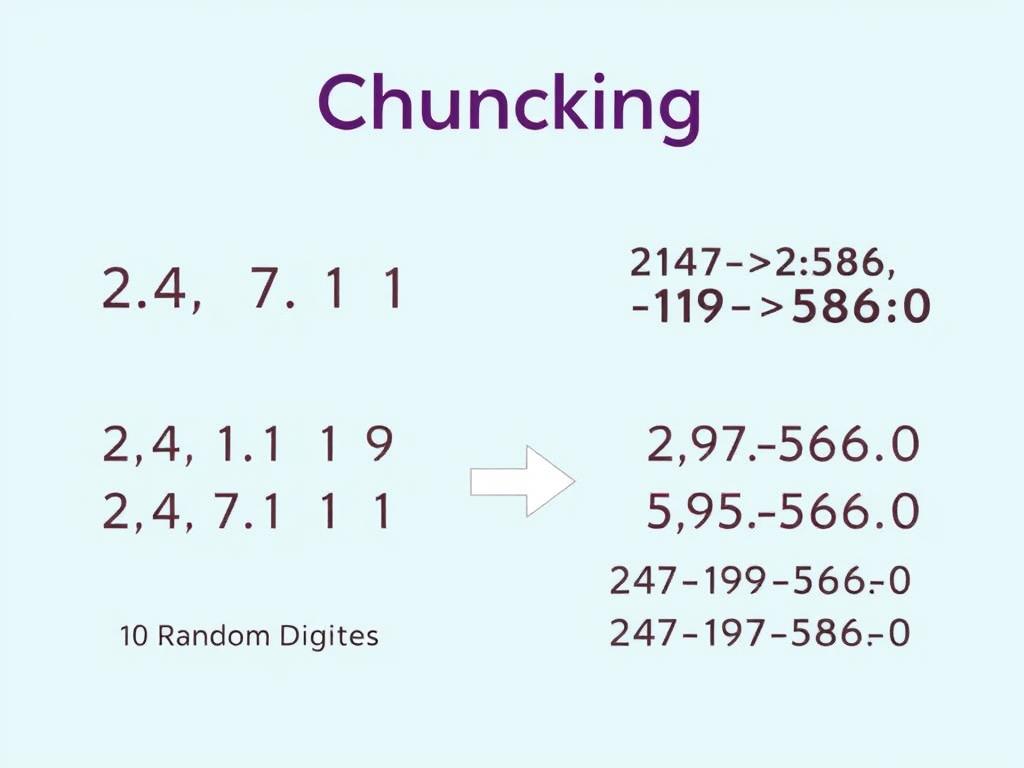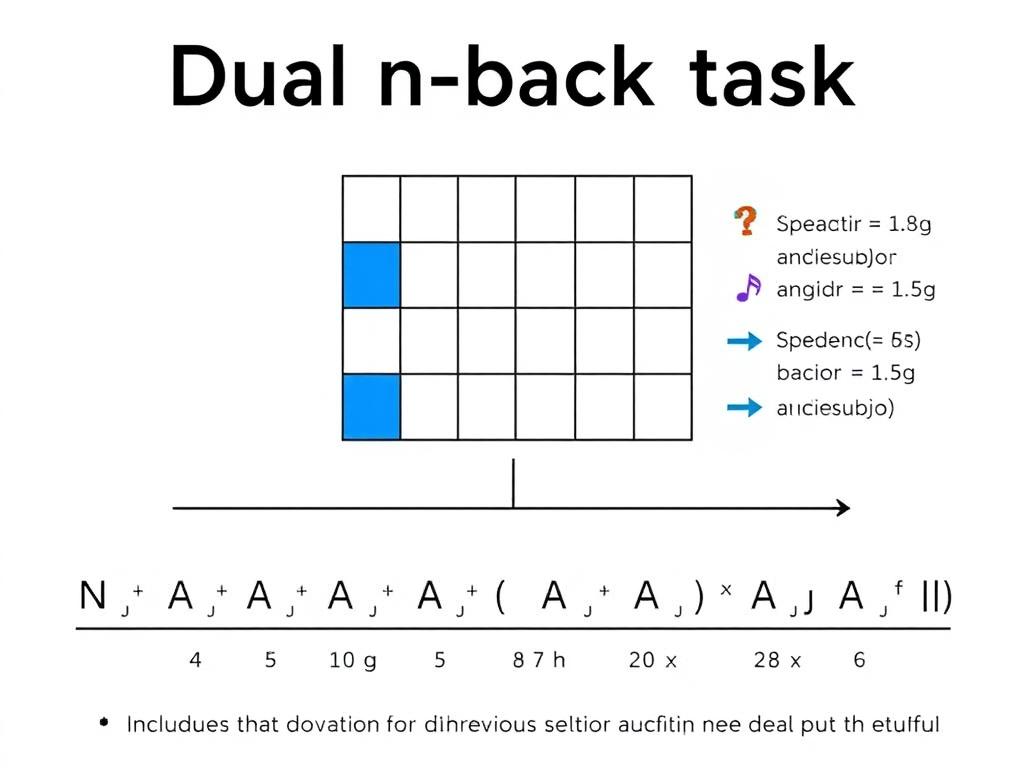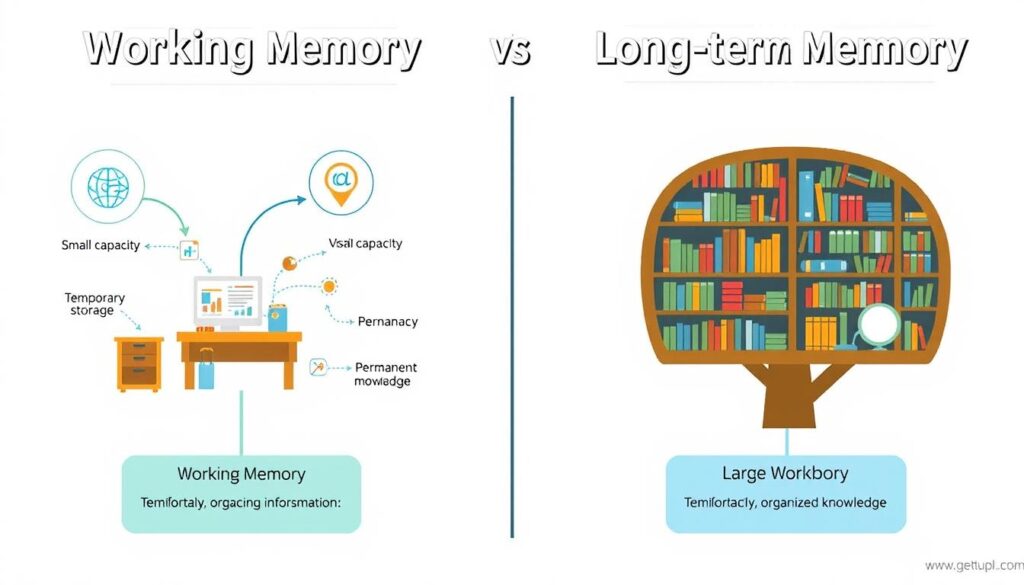Working memory functions as your brain’s notepad, allowing you to juggle multiple pieces of information simultaneously. Unlike long-term memory, which stores information indefinitely, working memory is limited in both capacity and duration. Most adults can hold only about 4-7 items in working memory at once. By strengthening this cognitive system, you’ll enhance your ability to focus, solve problems, and learn new information more efficiently.
Working memory allows us to temporarily hold and manipulate information while performing complex tasks.
1. Master the Art of Chunking Information
Chunking is a powerful technique that involves grouping individual pieces of information into meaningful units or “chunks.” This strategy effectively expands your working memory capacity by allowing you to remember more with less mental effort.

Chunking transforms individual pieces of information into meaningful groups, making them easier to remember.
Try This: Phone Number Chunking Exercise
Next time you need to remember a 10-digit phone number, instead of trying to hold all 10 digits separately in your mind, break it down into three chunks: area code (3 digits), prefix (3 digits), and line number (4 digits). For example, transform 5551234567 into 555-123-4567. This reduces your memory load from 10 separate items to just 3 chunks.
Daily Practice: Take a sequence of 10-15 random digits and practice grouping them into chunks of 3-4 numbers. Start with looking at the full sequence, then cover it and try to recall the chunks. With regular practice, you’ll notice improvement in just a few days.
Chunking works because your working memory has a limited capacity of about 4-7 items, but each “item” can be a chunk containing multiple pieces of information. By organizing information into meaningful groups, you’re essentially getting more storage space in your mental workspace.
2. Harness the Power of Mindfulness Meditation
Research shows that regular mindfulness meditation can significantly improve working memory by enhancing your ability to focus and reducing distracting thoughts. A 2013 study published in Psychological Science found that just two weeks of mindfulness training improved participants’ working memory capacity and reduced mind-wandering.

Regular mindfulness practice helps clear mental clutter and improves working memory function.
Try This: 5-Minute Focused Breathing
Set a timer for 5 minutes. Sit comfortably with your back straight and eyes closed. Focus your attention on your breathing—the sensation of air flowing in and out of your nostrils or the rising and falling of your chest. When your mind wanders (which it will), gently bring your attention back to your breath without judgment.
“The practice of mindfulness meditation has been shown to increase activity in the prefrontal cortex—the same brain region responsible for working memory functions.”
Start with just 5 minutes daily and gradually increase to 10-15 minutes. The key is consistency rather than duration. Even short daily sessions can yield noticeable improvements in your ability to stay focused and hold information in working memory.
3. Boost Brain Power with Physical Activity
Physical exercise isn’t just good for your body—it’s excellent for your brain too. Research published in the Journal of Cognitive Neuroscience demonstrates that aerobic exercise increases the size of the hippocampus, a brain area crucial for memory. Even a single session of moderate exercise can temporarily boost working memory performance.

Regular physical activity increases blood flow to the brain, enhancing cognitive functions including working memory.
Try This: The 10-Minute Movement Break
When you notice your concentration flagging or you’re struggling to hold information in mind, take a quick 10-minute movement break. Options include:
- A brisk walk around the block
- Climbing stairs for 5 minutes
- 10 jumping jacks followed by 10 squats, repeated 3 times
- Dancing to 2-3 of your favorite songs
The key is to get your heart rate up moderately—enough to feel slightly breathless but still able to hold a conversation. Return to your cognitive tasks afterward, and you’ll likely notice improved focus and working memory function.
Science Insight: Exercise increases levels of brain-derived neurotrophic factor (BDNF), a protein that supports the growth and maintenance of brain cells. Higher BDNF levels are associated with better memory performance.
For maximum benefit, aim to incorporate at least 150 minutes of moderate aerobic exercise into your weekly routine, spread across multiple days. Even short bursts of activity can provide immediate cognitive benefits.
4. Feed Your Brain with Memory-Boosting Nutrition
What you eat directly affects how well your brain functions. Certain nutrients are particularly beneficial for working memory performance. Omega-3 fatty acids, antioxidants, and B vitamins have all been linked to improved cognitive function.

Foods rich in omega-3 fatty acids, antioxidants, and B vitamins support optimal brain function.
Try This: Brain-Boosting Daily Menu
Breakfast: Greek yogurt with blueberries and walnuts (provides protein, antioxidants, and omega-3s)
Lunch: Spinach salad with salmon, avocado, and olive oil dressing (delivers omega-3s, healthy fats, and folate)
Snack: Dark chocolate (70%+ cacao) with a handful of pumpkin seeds (offers flavanols and zinc)
Dinner: Curry with turmeric, vegetables, and lean protein (curcumin in turmeric has anti-inflammatory properties that support brain health)
“The brain is an energy-intensive organ, using around 20% of the body’s calories. Good nutrition provides the fuel your brain needs for optimal working memory function.”
In addition to incorporating these brain-healthy foods, consider limiting refined sugars and highly processed foods, which can cause energy crashes and brain fog that impair working memory. Stay well-hydrated too—even mild dehydration can negatively impact cognitive performance.
While nutrition plays an important role in cognitive health, these dietary suggestions should complement, not replace, any medical advice. Always consult with healthcare professionals before making significant dietary changes.
5. Challenge Your Brain with Dual N-Back Training
The dual n-back task is one of the few cognitive training exercises with scientific evidence supporting its effectiveness for working memory improvement. This challenging mental exercise requires you to remember both visual and auditory information simultaneously while continuously updating your memory.

The dual n-back task trains your brain to hold and manipulate multiple types of information simultaneously.
Try This: Beginner’s Dual N-Back Practice
Start with a simple version of the exercise:
- Download a free dual n-back app on your smartphone (many options are available) or use an online version.
- Begin with the 1-back level: you’ll see a square appear in different positions on a grid while simultaneously hearing letters.
- Your task is to indicate when the current position or letter matches what appeared one step back.
- Practice for 10-15 minutes daily, gradually increasing to 2-back, 3-back, and beyond as your skills improve.
The dual n-back task is challenging at first, but with consistent practice, most people see improvement within 2-3 weeks. As you progress to higher n-back levels, you’re effectively expanding your working memory capacity.
Research Note: A study published in the Proceedings of the National Academy of Sciences found that participants who practiced the dual n-back task for 25 minutes per day showed significant improvements in fluid intelligence, which is closely related to working memory capacity.
For best results, practice when you’re mentally fresh, such as in the morning. Start with just 10 minutes daily and gradually increase your training time. The key is consistency—regular practice yields better results than occasional longer sessions.
6. Prioritize Quality Sleep for Memory Consolidation
Sleep isn’t just rest for your body—it’s essential processing time for your brain. During sleep, your brain consolidates information from working memory into long-term memory and clears out mental clutter, preparing your working memory system for optimal performance the next day.

Quality sleep allows your brain to process information and prepare working memory systems for optimal function.
Try This: Sleep Optimization Routine
1. Consistent Schedule: Go to bed and wake up at the same times daily, even on weekends.
2. Wind-Down Period: Create a 30-minute pre-sleep routine without screens (try reading, gentle stretching, or meditation).
3. Environment Optimization: Keep your bedroom dark, quiet, and cool (65-68°F/18-20°C is ideal).
4. Limit Stimulants: Avoid caffeine after 2 PM and alcohol close to bedtime.
5. Light Management: Get morning sunlight exposure and reduce blue light from screens in the evening (use night mode or blue-light blocking glasses).
6. Worry Journal: Write down concerns before bed to prevent them from cycling in your mind.
“Sleep is the golden chain that ties health and our bodies together. Not only does it heal your body, but it also optimizes your brain’s working memory systems.”
Most adults need 7-9 hours of quality sleep for optimal cognitive function. Even a single night of poor sleep can reduce working memory capacity by up to 40%. If you’ve been sacrificing sleep to get more done, recognize that this approach actually reduces your cognitive efficiency and working memory performance.
Quick Sleep Assessment: If you wake up naturally (without an alarm) feeling refreshed, you’re likely getting enough quality sleep. If not, prioritize the sleep optimization strategies above.
7. Manage Stress to Protect Working Memory
Chronic stress is kryptonite for working memory. When you’re stressed, your brain releases cortisol, which can impair the prefrontal cortex—the brain region responsible for working memory function. Learning to manage stress effectively can preserve and enhance your working memory capabilities.

Effective stress management protects your prefrontal cortex, the brain region critical for working memory.
Try This: 4-7-8 Breathing Technique
This powerful breathing exercise activates your parasympathetic nervous system (rest-and-digest mode), quickly reducing stress and improving mental clarity:
- Sit comfortably with your back straight.
- Place the tip of your tongue against the ridge behind your upper front teeth.
- Exhale completely through your mouth, making a whoosh sound.
- Close your mouth and inhale quietly through your nose for a mental count of 4.
- Hold your breath for a count of 7.
- Exhale completely through your mouth with a whoosh for a count of 8.
- Repeat this cycle 3-4 times when you feel stressed or need to clear your mind.
This technique can be used anytime you notice stress affecting your thinking—before important meetings, during study sessions, or when you’re feeling overwhelmed with information.
Research Insight: Studies show that chronic stress actually causes physical changes to neurons in the prefrontal cortex, reducing their connectivity and impairing working memory function. Regular stress management can prevent and even reverse these effects.
In addition to breathing techniques, regular exercise, adequate sleep, social connection, and time in nature are all evidence-based approaches to managing stress and protecting your working memory. Even brief moments of stress management throughout your day can have cumulative benefits for cognitive function.
Understanding the Difference: Working Memory vs. Long-Term Memory
To effectively improve your memory, it’s important to understand the distinction between working memory and long-term memory. These two systems work together but serve different functions in your cognitive processes.

Working memory and long-term memory serve different but complementary functions in your cognitive system.
Working Memory:
- Capacity: Limited to approximately 4-7 items
- Duration: Temporary (seconds to minutes)
- Function: Actively manipulates information for immediate tasks
- Attention: Requires conscious attention
- Example: Holding a phone number in mind while dialing
Long-Term Memory:
- Capacity: Virtually unlimited
- Duration: Potentially lifelong
- Function: Stores knowledge and experiences
- Attention: Can be unconscious
- Example: Remembering your childhood home or how to ride a bike
Working memory acts as a mental workspace where you temporarily hold and manipulate information needed for complex cognitive tasks like reasoning, comprehension, and learning. Think of it as your brain’s scratchpad or whiteboard. In contrast, long-term memory is your brain’s vast storage system, holding everything from facts and concepts to personal experiences and procedural knowledge.
The relationship between these systems is bidirectional. Working memory pulls relevant information from long-term memory when needed for current tasks. Simultaneously, information in working memory that receives sufficient attention and processing can be transferred to long-term memory for future use. The techniques in this article primarily target working memory, but strengthening this system also enhances your ability to encode information into long-term memory.
“Working memory is not just a gateway to long-term memory—it’s the active mental workspace where thinking happens. By improving it, you enhance your ability to process information effectively in the moment.”
Start Boosting Your Working Memory Today
You don’t need expensive programs or special equipment to improve your working memory—just consistent application of the science-backed techniques we’ve explored. Even small daily practices can yield significant improvements in your ability to hold and manipulate information.
Ready to transform your working memory?
Choose just one technique from this article and commit to practicing it daily for the next week. Notice how your ability to focus, learn, and solve problems improves as your working memory strengthens.
Start Your Memory-Boosting Journey Today
Remember that working memory improvement is not an overnight process—it requires consistent practice. However, many people report noticeable improvements within just 2-3 weeks of regular application of these techniques. The key is to integrate these practices into your daily routine rather than treating them as occasional exercises.

With improved working memory, you’ll handle complex tasks with greater ease and efficiency.
By strengthening your working memory, you’re investing in a fundamental cognitive skill that supports nearly every aspect of your thinking and learning. Whether you’re a student trying to master new material, a professional juggling multiple projects, or simply someone who wants to stay mentally sharp, these techniques offer practical ways to enhance your cognitive capabilities.
Which technique will you try first? Your journey to better working memory starts now.
How quickly can I expect to see improvements in my working memory?
Most people notice subtle improvements within 1-2 weeks of consistent practice. More significant changes typically become apparent after 3-4 weeks. The key is consistency—even 10-15 minutes of daily practice is more effective than occasional longer sessions.
Can these techniques help with age-related memory decline?
Yes, research suggests that these techniques can be particularly beneficial for older adults. While some cognitive decline is normal with aging, studies show that regular mental exercise, physical activity, stress management, and proper nutrition can help maintain and even improve working memory function regardless of age.
Will improving my working memory help with learning new skills?
Absolutely. Working memory is fundamental to learning new information and skills. When your working memory is stronger, you can hold and manipulate more information simultaneously, making connections between new and existing knowledge more efficiently. This enhanced processing capability directly supports faster and more effective learning.













